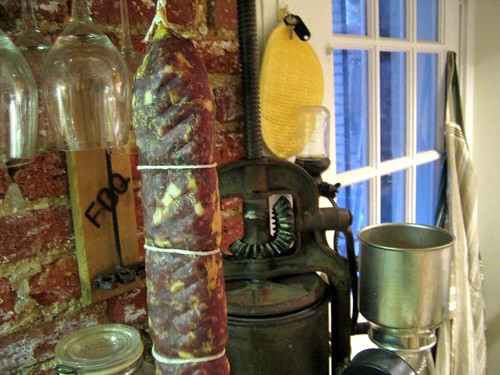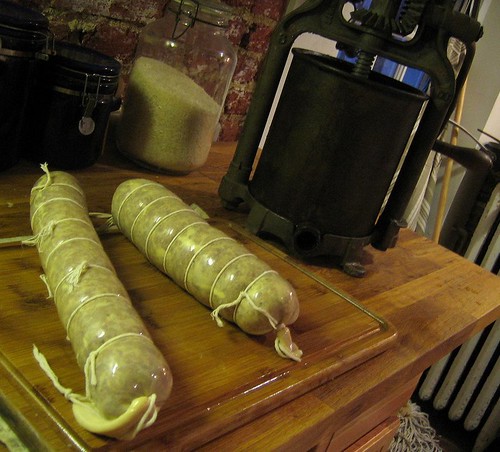
A liberal interpretation of “rosette” since a beef middle was use in lieu of the traditional and difficult to source pork rosette, the veritable terminus of the pig’s digestive tract whose shape and alleged “odor” give the rosette its reputed characteristic taper and… taste? After intense research through both professional and artisanal French charcuterie formulations, and a disastrous beta version, a widow of imperative seasoning proportions was tentatively established and put to test. The salt proportions varied from a well keeled 1.5% to a 3.5% Superbowl party saltlick.
Initially, based on the recurring 2.8%, such a quantity of salt was used but the result was unsavory, or rather extra savory and on the cusp of parching. And so the first foray into dry cured sausage (2 pieces) was unsuccessful but taught a fundamental lesson in fermentation after too lengthy of an incubation. The basement kitchen was thought to have been sufficiently cool and dark enough to support a longer incubation period but after a week in the upper 60’s, despite shrinking, both began to ferment. A better approach would have been to refrigerate one earlier and then compare notes.
Both sausages were refrigerated for 6 weeks in a home refrigerator at a cooler temperature than what would be ideal (44˚F so that other immediate perishables would not spoil) and began to develop a slight bloom after the 3rd week. The test of taste was a formidable challenge in gustatory fortitude after the first cut given that the cavities in the sausage were lined with spectacular green mold (insert blushing emoticon). The ends were salvageable and had a distinctively cured taste, though in the heavier spectrum of salty. Invariably, as with any endeavor, elements of theory and practice were learned at the expense of a failed product and applied to the next since anything worth ef’ing up once is worth ef’ing up twice and maybe thrice.
The 2.0 version was limited to 2.2% salt, the same .5% sugar (to help in the initial fermentation which creates lactic acid and bla-bla-bla) and 48 hours incubation, then into the fridge. After 4 weeks:
Current conclusion:
The 48hr incubation period, as recommended by Len Poli and other resources appears to have been effective and the sausage feels firm which would indicate that there are no cavities. Next update in another 4 weeks.


No comments:
Post a Comment